GEOSITES – NEWBIE OR IN THE KNOW?
A geosite is a site of geological interest, representing the incredible variety found in our landscape, based on their geological, educational or cultural importance.
Here in the Folkestone area we are lucky enough to have an amazing nine geosites.
THE CHALK THAT LINKS KENT AND FRANCE
The Kent and French coasts are still connected today by the layer of chalk which runs below the English Channel (or La Manche!). In fact, the Kent Downs Organisation is working with our neigbouring protected landscape in France, the Parc Naturel Regional des Caps et Marais d’Opale, to secure UNESCO Cross-Channel Global Geopark status for the Kent Downs National Landscape and its French counterpart.
THE CHANNEL TUNNEL
Let’s start with the big one – the Channel Tunnel is one of the modern engineering wonders of the world. It is the longest underwater tunnel in the world and the third-longest train tunnel in the world.
Tunnelled straight through the geology of the Cross-Channel Geopark, this extraordinary feat has also permanently reconnected France and Britain after over 450,000 years of separation.
Folkestone is the place to board your LeShuttle (formerly Eurotunnel) car train to France, ideally spending a few days here on either side of your trip to check out what we have to offer!
For more information about your trip visit www.leshuttle.com
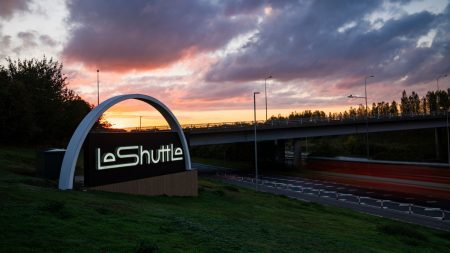
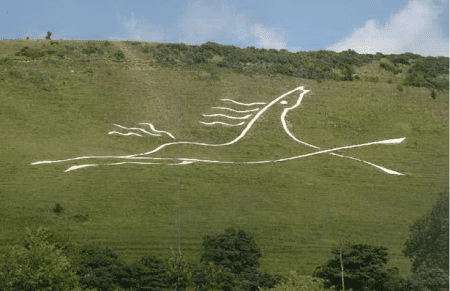
FOLKESTONE DOWNS
The hills behind Folkestone are a classic example of a Chalk escarpment – the steep side (scarp) of the Chalk ridge that is the North Downs.
Like other sites that sit on the top of the escarpment, the downs are best known for their stunning views over Folkestone and out across the Channel to France. And, more recently, as the home of the Folkestone White Horse, a stunning figure carved into the chalk in 2003.
The scientific importance of this site is recognised in its status as a Special Area of Conservation (SAC) and a Site of Special Scientific Interest (SSSI) for both its geodiversity and biodiversity. Part of the site, Holywell Coombe, has been found to have been occupied by humans over 4,000 years ago, and fossils found in this Coombe have also led to its inclusion in the Geological Conservation Review (GCR).
The Downs are managed by the White Cliffs Countryside Partnership (WCCP), who work to protect the important geology and wildlife whilst also ensuring people can visit the site and learn about the wildlife here. You can easily reach the Downs by bus, and it’s also on the North Downs Way, as well as being connected to Folkestone by various footpaths. So why not pay a visit and keep an eye out for some rare orchids, butterflies and other wildlife (if you’re not distracted by the incredible views, that is!).
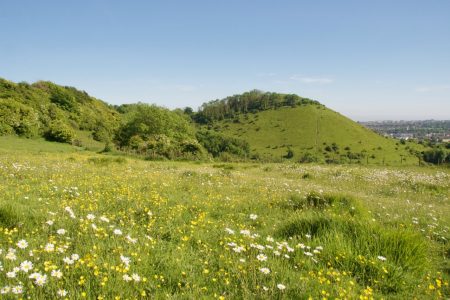
FARTHING COMMON AND POSTLING DOWN
Another great viewpoint is Farthing Common, sitting at the junction of the former Roman road, Stone Street, the ancient Pilgrim’s Way and the more recent addition of the North Downs National Trail. Travellers have likely stopped here at the top of the hill and admired the views for thousands of years, and who can blame them?!
Just along the North Downs Way from the Farthing Common viewpoint you can find Postling Down.
In this area you can see an unusually clear example of how the landscape has been formed by ancient processes, in this case either erosion by a stream or river or of mass movement similar to that which created the Devil’s Kneading Trough a bit further northwest of here.
Sites such as Postling Down are great places to gain an understanding of how, despite chalk having been formed 100-60 million years ago, it is the relatively recent erosion processes that happened at the end of the last Ice Age (around 12,000 years ago) which carved out the rough shape of the landscape we know and love today.
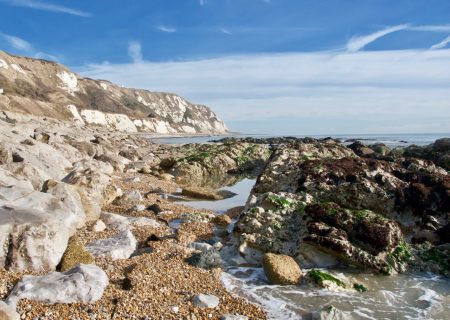
FOLKESTONE HARBOUR AND THE WARREN
The coastal area stretching from the eastern edge of Folkestone to the western edge of Dover is truly unique, with an incredible combination of man-made and natural features intertwining to produce this special location.
The Warren is one massive landslip, caused by the fact that a layer of wet, impermeable clay meets the bottom point of the permeable chalk right in between the low and high tide mark, meaning the Chalk cliffs are constantly ‘slipping’ on the wet clay. To combat this, the concrete apron running along the shoreline was built to stop the cliffs slipping into the sea!
Because the Folkestone-Dover trainline passes through the Warren at the foot of the cliffs, this area is one of the most intensely studied landslips anywhere in the world.
The cliff faces along the coast here are also some of the first rocks ever studied by geologists (before the study of ‘geology’ even existed!).
The darker, green cliffs close to Folkestone Harbour are made up of layers of gault clay and greensand. The gault clay layer is the ‘type section’ for this type of rock, meaning that wherever it is found in the world geologists refer back to this cliff to identify exactly what it is. The gault clay is also full of fossils which you can often find on the beach at the western end of the Warren.
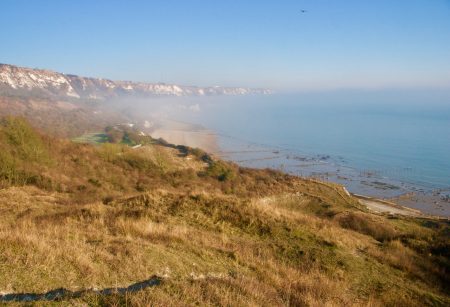
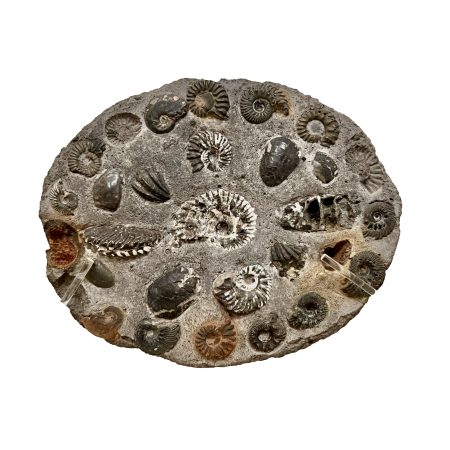
FOLKESTONE MUSEUM
Folkestone sits close to the middle of the Cross-Channel Geopark, and its coastal location has given rise to a rich history including some of the earliest geological studies, a Roman villa, and the first attempts to dig a tunnel under the Channel. The Folkestone Museum is the perfect place to discover this history, with collections including ancient quern stones linked to the beginning of Cross-Channel trade, Roman tiles and other artefacts and the maritime history of the town, which has been defined by its proximity to France.
Perhaps the most impressive collection of all at Folkestone Museum is the natural history collection.
Many of the most extraordinary fossils that have been found along the Folkestone coastline over hundreds of years can be discovered at the museum, alongside extraordinary collections of butterflies and moths. The very first Folkestone Museum, opened in 1858, was actually based upon the huge collection of fossils that local resident Samuel Mackie had built up, much of which is still on display today.
For more information visit www.folkestonemuseum.co.uk
BROCKHILL COUNTRY PARK
Brockhill Country Park offers a variety of different settings and wildlife, alongside great facilities and activities. A walk through the whole of Brockhill Park takes you from open hillsides down through patches of bamboo and ferns to a shaded lake, on past woodland streams and back out into meadows grazed by sheep and cattle.
Along the way you can spot lots of wildlife including woodpeckers, kingfishers, butterflies and snowdrops.
Besides the wildlife on offer there are plenty of other activities, including a kids play area, orienteering, geocaching and a great programme of events throughout the year. With excellent facilities including accessible toilets and a great vegetarian cafe, Brockhill Park is the perfect place for a relaxing wander in nature or a family day out.
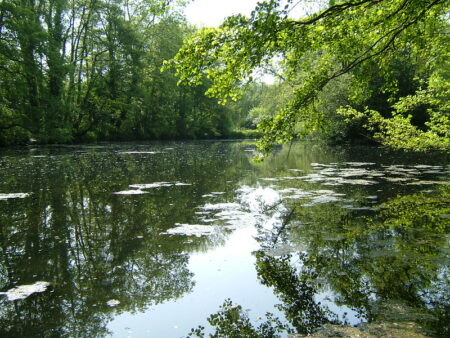
For more information, visit www.kentdowns.org.uk/geopark/geosites/